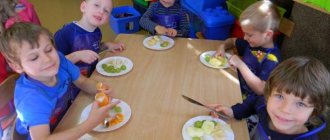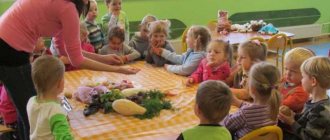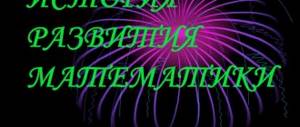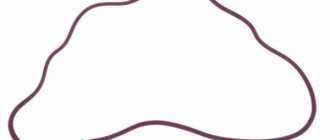Presentation “Vegetables and fruits - vitamin products” presentation for the lesson (senior group) on the topic
Slide 1
Vegetables and fruits are the most vitamin-rich foods!
Slide 2
Round, ruddy, I grow on a branch; Adults and little children love me.
Slide 3
There is a miracle in the green garden: Leaves brighter than emerald, Silver flowers And fruits like the sun.
Slide 4
In the summer - in the garden, Fresh, green, And in the winter - in a barrel, Strong, salty.
Slide 5
Balls are hanging on the branches - Turned blue from the heat!
Slide 6
He will make everyone around him cry, Although he is not a fighter, but...
Slide 7
What's that squeak? What's that crunch? What kind of bush is this? How can there be no crunch? If I…
Slide 8
The head is on a leg, there are polka dots in the head.
Slide 9
What are vitamins? These are substances necessary to maintain the health of our body. There are a lot of these substances in vegetables and fruits. Which ones exactly? Let's get to know some of them.
Slide 10
Onions and garlic have long been famous for their medicinal properties. These vegetables contain a large amount of vitamin C. Inhaling the vapors of onions and garlic helps with coughs and sore throats. A mixture of onion and garlic helps with a runny nose. Both of these plants serve us both as food and medicine.
Slide 11
Just 400 years ago, our ancestors did not even know about the existence of cucumbers. And today, no matter who you visit, you will definitely be offered some kind of cucumber dish: salad, vinaigrette, or just pickles.
Slide 12
Carrots contain a large amount of vitamin A, which strengthens the body and protects it from infections, and also has a positive effect on vision. However, carrots are not only a piggy bank of vitamin A. They contain almost the entire vitamin alphabet.
Slide 13
Beetroot is one of the healthiest vegetables. It contains a lot of ascorbic acid (vitamin C) and vitamin B. If we want to preserve more vitamins in beets, then we need to eat them raw.
Slide 14
Tomato, or tomato, came to us from South America. At first, the tomato was used to decorate flower beds and window sills. Then they began to grow it as a medicinal plant, and only then it settled in gardens and began to be eaten. Tomatoes contain vitamins C and B.
Slide 15
In everyday life we often call radishes radishes. This is one of the first fresh vegetables to appear on our table after a long winter. Radishes contain a large amount of ascorbic acid and vitamin B.
Slide 16
Our ancestors have been eating turnips for several centuries. They eat it raw, boiled, steamed. This is a healthy vegetable. The famous Russian folk tale “Turnip” is even dedicated to him.
Slide 17
Apples are the most valuable fruit among our domestic fruits. Among fruits, this can be said to be our daily bread. We don't have fresh apples for almost a whole year. They give strength, prolong youth and help fight diseases.
Slide 18
After apples, pears are our most common fruit. They learned about the pear later than about the apple tree. Ancient physicians used pear juice to quench thirst in patients with elevated body temperature. Pear juice and decoction were used to treat indigestion. Pears contain a lot of vitamins B and C.
Slide 19
Lemon is rich in ascorbic acid, that is, vitamin C, which increases the body's resistance to infectious diseases, especially colds. That's why doctors recommend lemon as a preventative against the flu.
Slide 20
Oranges appeared in Russia in the 18th century. But the plant itself does not tolerate cold weather. Therefore, they can only be grown in greenhouses.
Slide 21
For many centuries, grapes have attracted human attention. Enjoyed his love. To treat many diseases, people used not only berries, but also leaves. Grape berries contain large amounts of ascorbic acid (vitamin C) and vitamin B. Fresh grape juice is one of the healthiest and most delicious drinks.
Slide 22
Melon is a valuable food and dietary product. Its fruits are eaten not only fresh, but also dried and dried; delicious jams, jams, candied fruits and marinades are also prepared from them. Melon contains a lot of vitamin B.
Slide 24
If you want to grow well, see well and have strong teeth, you need Vitamin A.
Slide 25
If you want to be strong, have a good appetite and don’t want to get upset over trifles, you need Vitamin B.
Slide 26
If you want to catch colds less often, be cheerful, and recover faster from illness, you need Vitamin C.
Slide 27
If you eat carrots, you will run a hundred meters. If you eat a cucumber, you'll be great! Put a lemon in your tea and drink vitamin heaven! Vegetables and fruits are the most vitamin-rich foods! These are some healthy vegetables and fruits! They even came up with proverbs and sayings about them!
Lesson summary + presentation on the topic “Why you need to eat a lot of vegetables and fruits” for 1st grade
Objectives:
1.Expand and systematize students’ knowledge about vegetables and fruits. 2.Introduce the beneficial properties of vegetables. 3. Introduce vitamins and reveal their significance for humans. 4. Develop healthy lifestyle skills, repeat the rules of hygiene. 5.Develop logical thinking, imagination, creativity. 6. Cultivate a desire to take care of your health and treat it with care.
Equipment:
1. dummies and pictures of vegetables and fruits, 2. details of costumes for “vitamins”, 3. magnetic board, 4. colored pencils, 5. TSO.
Lesson type:
Learning new material.
Lesson plan:
1. Organizational moment. 2. Statement of the topic, goals and objectives of the lesson. 3.Formation of new knowledge. 4. Physical education minute. 5.Formation of new knowledge (continued) 6.Educational point about hygiene. 7. Fastening. 8. Lesson summary.
During the classes
1. Organizational moment Everyone knows, everyone understands that it’s nice to be healthy. You just need to know how to become healthy. Today we are going to a healthy country. We will declare war on diseases there! — The Wise Turtle and the Question Ant invite us on a journey through the planet of Proper Nutrition. Slide2
2. Setting the topic, goals and objectives of the lesson. — While traveling, we must answer the question: “Why do you need to eat a lot of vegetables and fruits?” Be very careful, because on the planet there is a Zlyuchka - a Muddy. She may interfere with our journey. And as always, our faithful friends the Wise Turtle and the Question Ant will help us. Slide3
3. Formation of new knowledge. a) Fasten your seat belts and put on your helmets. - So, let's go!!! Listen to an excerpt from the poem and find out which country we are about to fly to.
One day the housewife came home from the market. The housewife brought home potatoes, cabbage, carrots, peas, parsley and beets. Slide 4
- Who remembered what the hostess brought? What can we call it in one word? Who guessed what country we flew to? (Country of Vegetables.) slide 5 - The inhabitants of this country have prepared a task for you. Solve riddles.
b) Open the textbooks “The World Around Us” page 38 - Look at the pictures. What do you see? (drawings of vegetables and fruits and their names). Drawings of vegetables will help you solve riddles. Take a simple pencil and connect the drawing and the title with lines. Slide6
Children in costumes ask riddles - In the garden bed it is long and green, And in the tub it is yellow and salty. (Cucumber)
- They threw the Golden feathers off Yegorushka - Made Yegorushka cry without grief. (Onion)
- Little, bitter brother of Luka. (Garlic)
- Round side, yellow side, Gingerbread Man sits in the garden bed. Rooted firmly into the ground. What is this? (Turnip)
- On the ground there is grass, Under the ground there is a scarlet head. (Beet)
- The girl is sitting in prison, and her braid is on the street. (Carrot)
— What other vegetables are depicted? (Children list) Tomato, radish slide 6 - What other vegetables do you know? (potatoes, peas, eggplant, zucchini, radish, cabbage) - Well done! How many vegetables do you know?
c) - You coped well with the tasks of the inhabitants of the country and they give you poems about the benefits of vegetables. (3 students come out and talk).
I'm healthy, I'm healthy, although I'm not tall. I won’t eat cutlets - Fry the zucchini for me.
I'm a rosy girl and I dance smartly! Because I always eat fresh carrots.
We don’t get the flu anymore We’re not afraid of drafts All the pills are replaced by a head of garlic. d) - Although your vegetables are fun, it’s time for us to hit the road. - And we flew to the country of Vitamins. Slide 7
What's the tastiest thing in the world? Have you thought about candy? But I'm talking about vitamins. We will find them in tangerines, in pineapples and bananas, that grow in distant countries. And let’s not forget about the pear. Every fruit is good for people.
- But what is it? In this country, an evil witch has bewitched all the inhabitants and we must help them. - Shall we help? We need to solve the crossword puzzle. The fruits helped us a little and inserted some letters. Slide 7
— Words of lines No. 1,4,5,6,7.
we will find on the textbook page38. No. 3 a small stove with red coals pomegranate No. 2 the younger brother of the orange tangerine No. 7 how to call everything in one word? Fruits For the full text of the material, lesson notes + presentation on the topic “Why you need to eat a lot of vegetables and fruits” for grade 1, see the downloadable file
. The page contains a fragment.
| Author: Rulnova Yulia Nikolaevna → RULNOVA 10/14/2010 21 43747 8835 | Comment |
Thank you for your mark. If you want your name to be known to the author, log in to the site as a user and click Thank you again. Your name will appear on this page.
Login | Registration
Have an opinion? Leave a comment
Project for children of the second junior group "Vegetables and fruits are healthy products."
Project for children of the second junior group “Vegetables and fruits are healthy products”
Project for children of the second junior group “Vegetables and fruits are healthy products”
Project passport
:
“ Vegetables and fruits are healthy products ”
Project type
: cognitive-creative
Project participants
: teacher, children
of primary
preschool age, parents of pupils
Implementation period: September 2020
Duration
: short-term
Relevance of the project
: Nature gives a lot of beautiful, tasty,
healthy things
.
Autumn is especially generous with gifts. How many delicious fruits and vegetables
ripen in people's gardens and orchards.
Children of primary
preschool age have insufficient understanding of
vegetables and fruits
, where they grow, and their role in maintaining and promoting health.
In the project “ Vegetables and fruits are healthy products ”
Children learn to classify, compare and generalize the knowledge they have acquired, which contributes to the mental development
of children
and develops interest.
Objective of the project
: Expand and enrich
children's knowledge about vegetables and fruits
.
Tasks:
Cognitive development: expand children's understanding of the variety of fruits
,
vegetables
and where they grow. Fix the names of colors, shapes, sizes.
Speech development: expand and activate children's
, to develop the ability to select adjectives for nouns.
Social and communicative development: to develop the ability to work in a team. During games, develop interest in the world around you; follow the rules of behavior in nature.
Artistic and aesthetic development: learn to convey the color and shape of fruits
,
vegetables
; to develop skills in the artistic performance of various images in songs and emotional responsiveness to the work.
Physical development: develop all types of motor skills: general, fine, articulatory. Develop the ability to coordinate speech with movements. Develop a sense of rhythm. Form an idea of a healthy lifestyle - wash your hands before eating, wash vegetables
,
fruits
.
Expected result.
1. In children
stable ideas will be formed about
fruits
,
vegetables
, where they grow, that they are
healthy and tasty
.
2. Increase cognitive interest in fruits
,
vegetables
, mushrooms, there will be a desire to help adults in harvesting.
3. Expand children's
.
4. Children will learn to love, protect and preserve nature, follow the rules of safe behavior in the garden.
5. Parents will increase their interest in the life and activities of children in the group
, they will be involved in the educational process.
Project implementation stages
:
Stage I - preparatory:
children were identified
initial knowledge on this topic, as well as enrichment of the subject-development environment, selection of materials and equipment for educational activities, conversations, games with children, selection of fiction, songs, didactic, role-playing games, finger and story gymnastics on the topic of
the project
.
Stage II – main: project
through various activities
Activities Contents
Cognitive and research - Examination of illustrations depicting vegetables and fruits
.
— NOD “What autumn brought us”
.
— View the presentation “Gifts of Autumn”
.
— Conversations: “What autumn gave us”
,
“What grows in the beds, what grows in the garden”
,
— Game situations “Let’s tell Ushastik”
about
vegetables and fruits
”,
“The benefits of vegetables ”
,
“The benefits of fruits ”
.
-Consideration and comparison of vegetables
,
fruits (by shape, size, length, taste)
-Excursion to the vegetable garden.
Game activity - D/i “ Vegetables and fruits ”
,
“What grows where?”
,
“Wonderful bag”
,
“The fourth odd one”
,
“What’s missing?”
,
“Guess the taste”
,
“Tops and roots”
, “Guess the rule!
— Outdoor games and exercises:
"By the Bear in the Forest"
,
“Cucumber, cucumber”
,
“Bear and Vegetables ”
- Board and printed games:
Cut-out pictures, “Find a pair”
,
“ Vegetables and fruits ”
,
“Pick a picture”
- Role-playing games:
"In the shop"
,
“Masha’s doll’s birthday”
,
“Mom is preparing dinner”
.
— Finger games: “We’re making compote”
,
“Orange”
,
“Cabbage”
,
“Lariska has two radishes”
.
— Games with building materials “We’re going for the harvest”
.
Communication activities – NOD “Wonderful Basket”
— Looking at vegetables
;
— Guessing riddles on the topic.
— Learning poems, riddles about vegetables
— Reading fiction Reading folk songs, fairy tales: “Turnip”
,
"Tops and Roots"
.
V. Korkina. “What grows in our garden bed”
, E. Blaginina
“Come to the garden”
Productive
activity - Drawing
“Apples and pears lie on a plate”
;
-Modeling “Carrot for a bunny”
— Application “Preparing vegetables and fruits for the winter ”
Musical and artistic activities - Learning and listening to musical compositions
— Dramatization of the fairy tale “Turnip”
Interaction with family:
-Consultations for parents “Dishes from vegetables and fruits ”
,
“ Vegetables and fruits are healthy products ”
- Joint production of visual material “Wonderful Basket”
Stage III - final:
Productive activities of children
:
— exhibition of children’s “ Vegetables on a plate ”
,
“Carrots for the bunny”
,
“Preparing vegetables for the winter ”
.
— Autumn holiday at the preschool educational institution.
— Participation of parents of pupils in the competition “Miracle Vegetable ”
.
— Making the “Wonderful Basket”
— Generalization of project material and its design
.
Conclusions:
During the project, children learned
that
vegetables
and
fruits
.
That vegetables
ripen in the garden beds;
fruits in the garden
.
They are healthy and tasty
.
Project results
.
Children’s knowledge about fruits has expanded and enriched
,
vegetables
, mushrooms.
Children’s vocabulary has expanded
.
3. Children’s
.
4. Children know the rules of safe behavior in the garden.






